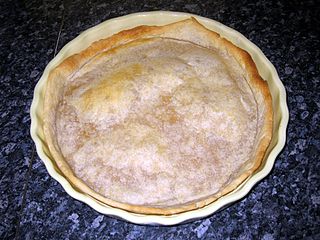
Pastry refers to a variety of doughs, as well as the sweet and savoury baked goods made from them. These goods are often called pastries as a synecdoche, and the dough may be accordingly called pastry dough for clarity. Sweetened pastries are often described as bakers' confectionery. Common pastry dishes include pies, tarts, quiches, croissants, and pasties.

A croissant is a French pastry made from puff pastry in a crescent shape.

A Danish pastry is a multilayered, laminated sweet pastry in the viennoiserie tradition. It is thought that some bakery techniques were brought to Denmark by Austrian bakers, and originated the name of this pastry. The Danish recipe is however different from the Viennese one and has since developed into a Danish specialty.

A baker is a tradesperson who bakes and sometimes sells breads and other products made of flour by using an oven or other concentrated heat source. The place where a baker works is called a bakery.

Dough is a thick, malleable, sometimes elastic paste made from grains or from leguminous or chestnut crops. Dough is typically made by mixing flour with a small amount of water or other liquid and sometimes includes yeast or other leavening agents, as well as ingredients such as fats or flavourings.

Lebkuchen, Honigkuchen or Pfefferkuchen are honey-sweetened German cakes, moulded cookies or bar cookies that have become part of Germany's Christmas traditions. They are similar to gingerbread.

Gooey butter cake is a type of cake traditionally made in St. Louis, Missouri. It is a flat and dense cake made with wheat cake flour, butter, sugar, and eggs, typically near an inch tall, and dusted with powdered sugar. While sweet and rich, it is somewhat firm, and is able to be cut into pieces similarly to a brownie. Gooey butter cake is generally served as a type of coffee cake and not as a formal dessert cake. There are two distinct variants of the cake: the original St. Louis, MO Bakers' gooey butter and a cream cheese and commercial yellow cake mix variant. The original St. Louis, MO Bakers' gooey butter is believed to have originated in the 1930s. It was made with a yeast-raised sweet dough on the bottom.

A hamantash is an Ashkenazi Jewish triangular filled-pocket pastry associated with the Jewish holiday of Purim. The name refers to Haman, the villain in the Purim story. In Hebrew, hamantashen are also known as אוזני המן, meaning "Haman's ears". "Haman's ears" also refers to a Sephardic Purim pastry, "Orejas de Haman", thought to originate in Spain and Italy, that is made by frying twisted or rolled strips of dough.

Kuchen, the German word for cake, is used in other languages as the name for several different types of savory or sweet desserts, pastries, and gateaux. Most Kuchen have eggs, flour and sugar as common ingredients while also, but not always, including some fat. In the Germanosphere it is a common tradition to invite friends over to one's house or to a cafe between noon and evening to drink coffee and eat Kuchen.

A Berliner or Krapfen is a German jam doughnut with no central hole, made from sweet yeast dough fried in lard or cooking oil, with a jam filling, and usually covered in powdered sugar.

The Linzer torte is a traditional Austrian pastry, a form of shortbread topped with fruit preserves and sliced nuts with a lattice design on top. It is named after the city of Linz, Austria.
Zürcher Murren, also called pain bernois, Bernerweggen, Spitzweggen, geschnittene Weggli or Zackenweggen are a type of bread roll traditionally made in the German-speaking part of Switzerland and, more rarely, in the Romandy.

The Bündner Nusstorte, also known as Engadiner Nusstorte, is a traditional sweet, caramelised nut-filled pastry from canton Graubünden in Switzerland. The modern filled Nusstorte was first widely available in the 1960s though it was invented in the 1920s.

Zuger Kirschtorte is a Swiss layer cake that consists of layers of nut-meringue, sponge cake and butter cream, and is flavoured with the cherry brandy kirschwasser.

Spanisch Brötli is a speciality pastry from Baden, Switzerland. It is a light, flaky pastry filled with a mix of roasted, crushed hazelnuts and apricot jam. Its structure has a square of dough for the lower portion, apricot and hazelnut filling for the middle portion, and a square of dough for the upper portion. It has an "X" cut into the top to allow for the food to vent hot air during baking.

Wähe is a baked dish typical of Swiss and Alemannic (German) cuisine. A wähe consists of a casing and a topping of a custard enveloping either fruit, vegetables or cheese. The custard and fruits or vegetables are baked together. The preparation is thus very similar to that of the French quiche or tarte.

Pâte brisée is a variation on a traditional short-crust pastry dough. It is used as a base for various savory and sweet dishes. It is sometimes confused with a traditional flaky pie crust, which has similar ingredients, but the pâte brisée is considered superior for use with wet fillings such as custards. It is an unsweetened pastry typically used in savory dishes, though sweet dishes are known.















